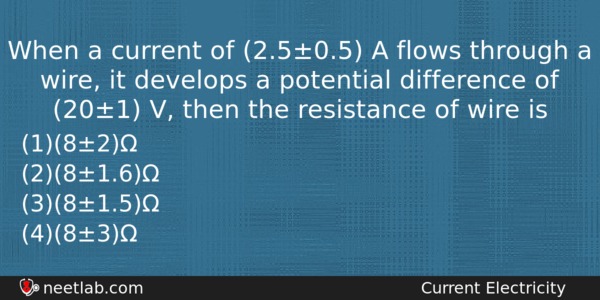| ⇦ | 
| ⇨ |
When a current of (2.5±0.5) A flows through a wire, it develops a potential difference of (20±1) V, then the resistance of wire is
Options
(a) (8±2)Ω
(b) (8±1.6)Ω
(c) (8±1.5)Ω
(d) (8±3)Ω
Correct Answer:
(8±2)Ω
Explanation:
No explanation available. Be the first to write the explanation for this question by commenting below.
Related Questions: - The electric vector vibration of an electromagnetic wave is given by
- A 1 kg particle strikes a wall with velocity 1 m/s at an angle 30° and reflects
- If the self inductance of 500 turn coil is 125 mH, then the self inductance
- A boat of mass 40 kg is at rest.A dog of mass 4 kg moves in the boat
- Two identical long conducting wires AOB and COD are placed at right angle
Topics: Current Electricity
(136)
Subject: Physics
(2479)
Important MCQs Based on Medical Entrance Examinations To Improve Your NEET Score
- The electric vector vibration of an electromagnetic wave is given by
- A 1 kg particle strikes a wall with velocity 1 m/s at an angle 30° and reflects
- If the self inductance of 500 turn coil is 125 mH, then the self inductance
- A boat of mass 40 kg is at rest.A dog of mass 4 kg moves in the boat
- Two identical long conducting wires AOB and COD are placed at right angle
Topics: Current Electricity (136)
Subject: Physics (2479)
Important MCQs Based on Medical Entrance Examinations To Improve Your NEET Score
18000+ students are using NEETLab to improve their score. What about you?
Solve Previous Year MCQs, Mock Tests, Topicwise Practice Tests, Identify Weak Topics, Formula Flash cards and much more is available in NEETLab Android App to improve your NEET score.
Share this page with your friends

R=V/I
R=20/2.5
R= 8 ohm
Now,
∆ R/R=∆ V/V+∆I/I
=1/20 +0.5/2.5
= 1/4
Therefore,
∆ R÷R=1÷4
∆ R=1÷4×R
∆R=1÷4×8
∆R=2
Therefore,
Resistance with error limits=R+ – ∆R
=(8+ – 2)ohm